文献翻译范例
外文文献翻译模板
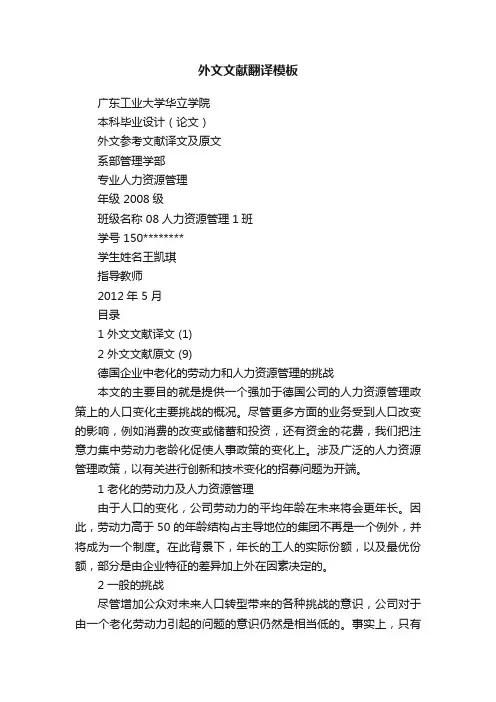
外文文献翻译模板广东工业大学华立学院本科毕业设计(论文)外文参考文献译文及原文系部管理学部专业人力资源管理年级 2008级班级名称 08人力资源管理1班学号 150********学生姓名王凯琪指导教师2012年 5 月目录1 外文文献译文 (1)2 外文文献原文 (9)德国企业中老化的劳动力和人力资源管理的挑战本文的主要目的就是提供一个强加于德国公司的人力资源管理政策上的人口变化主要挑战的概况。
尽管更多方面的业务受到人口改变的影响,例如消费的改变或储蓄和投资,还有资金的花费,我们把注意力集中劳动力老龄化促使人事政策的变化上。
涉及广泛的人力资源管理政策,以有关进行创新和技术变化的招募问题为开端。
1 老化的劳动力及人力资源管理由于人口的变化,公司劳动力的平均年龄在未来将会更年长。
因此,劳动力高于50的年龄结构占主导地位的集团不再是一个例外,并将成为一个制度。
在此背景下,年长的工人的实际份额,以及最优份额,部分是由企业特征的差异加上外在因素决定的。
2 一般的挑战尽管增加公众对未来人口转型带来的各种挑战的意识,公司对于由一个老化劳动力引起的问题的意识仍然是相当低的。
事实上,只有25%的公司预计人口统计的变化在长远发展看来将会导致严重的问题。
然而,现在越来越多关于老化劳动力呈现的挑战和潜在的解决方案的文献。
布施提出了一种分析老员工一般能力的研究文集,并给出有关于年长工人的人力资源政策的实例。
目前,华希特和萨里提出一篇关于研究公司对于提前退休的态度和延长工作生涯的态度的论文。
在这些研究中,老员工的能力通常被认为是不同的,并不逊色,同时指出一个最优的劳动力取决于不同的公司的特殊要求。
一般来说,然而由于越来越缺少合格的员工,人口统计的变化将使得在各种人事政策方面上的压力逐渐增加。
特别是,没有内部人力资源部门的中小型企业,因此缺乏足够的特殊的基础设施,则面临着严峻的挑战。
与他们正常的大约两到五年的计划水平相反,他们将越来越多地要处理长期的个人问题和计划。
最新外文文献翻译格式范例
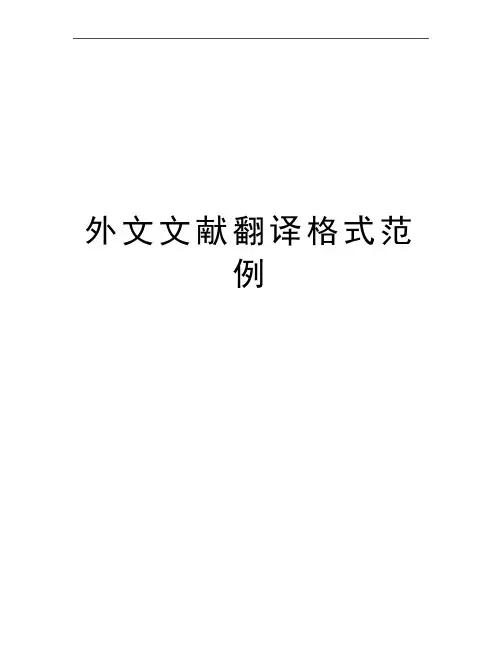
外文文献翻译格式范例本科毕业设计(外文翻译)外文参考文献译文及原文学院信息工程学院专业信息工程(电子信息工程方向)年级班别 2006级(4)班学号 3206003186学生姓名柯思怡指导教师 ______ 田妮莉 _ __2010年6月目录熟悉微软SQL Server (1)1Section A 引言 (1)2Section B 再谈数据库可伸缩性 (4)3Section C 数据库开发的特点 (7)Get Your Arms around Microsoft SQL Server (9)1Section A Introduction to SQL Server 2005 (9)2Section B Database Scalability Revisited (13)3Section C Features for Database Development (17)熟悉微软SQL Server1 Section A 引言SQL Server 2005 是微软SQL生产线上最值得期待的产品。
在经过了上百万个邮件,成百上千的规范说明,以及数十次修订后。
微软承诺SQL Server 2005 是最新的基于Windows数据库应用的数据库开发平台。
这节的内容将指出SQL Server 2005产品的一些的重要特征。
SQL Server 2005几乎覆盖OLTP及OLAP技术的所又内容。
微软公司的这个旗舰数据库产品几乎能覆盖所有的东西。
这个软件在经过五年多的制作后,成为一个与它任何一个前辈产品都完全不同的产品。
本节将介绍整个产品的大部分功能。
当人们去寻求其想要的一些功能和技术时,可以从中提取出重要的和最感新区的内容,包括SQL Server Engine 的一些蜕变的历史,以及各种各样的SQL Server 2005的版本,可伸缩性,有效性,大型数据库的维护以及商业智能等如下:●数据库引擎增强技术。
SQL Server 2005 对数据库引擎进行了许多改进,并引入了新的功能。
文献翻译格式参考
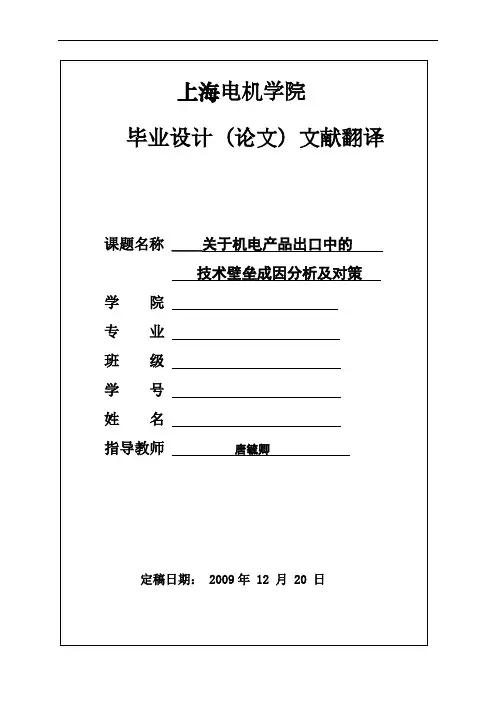
Quantifying the Trade Effects of Technical Barriers to Trade: Evidence from China 1. IntroductionTechnical barriers to trade(TBT)are now widespread and have increasing impacts on international trade. The spread of TBT may have some special reasons.First, it’s legitimate. The WTO members are authorized by WTO TBT/SPS Agreement to take such measures in order to protect human health, as well as animal and plant health, provided that the enforced measures are not disguised protectionism. Second, as Baldwin (1970) emphasized, ―The lowering of tariffs has, in effect, been like draining a swamp. The lower water level has revealed all the snags and stumps of non-tariff barriers that still have to be cleared away‖. Wallner (1998) considered this phenomenon as a ―law of constant protection‖, referring to perfect substitutability between tariff and none-tariff barriers in maintaining a degree of desired domestic protection.Third, with the trade liberalization process, the remaining barriers, like TBT have a more important but not a less important impact due to the ―globalization magnification effect‖, seemingly minor differences in technical norms can have an outsized effect on production and trade (Baldwin 2000). Fourth, the increasing income of importing country and consumer preference may result in a higher demand for product quality, safety and environment protection.Since the proliferation of TBT and its increasing trade-restrictive impacts, OECD (2001) drew attention to TBT and suggested more empirical research on it, becausethe quantitative analysis is an important step in the regulatory reform process and can help inform governments to define more efficient regulations. However, due to the theoretical complexity and data s carcity, TBT have been considered as ―one of the most difficult NTBs imaginable to quantify‖ (Deardorff and Stern 1997)So far, there is not a preferred quantification strategy and claims abound on both sides about―whether such restrictions tend to reduce trade by virtue of raising compliance costsor expand trade by increasing consumer confidence in the safety and quality of imported goods‖ (Maskus and Wilson 2001).Maskus and Wilson (2001), Maskus, Otsuki, and Wilson (2001), Beghin and Bureau (2001), Ferrantino (2006) and Korinek, Melatos and Rau (2008) etc provide comprehensive overviews of key economic issues relating to TBT modeling and measurement. Based on these literatures, quantification techniques can be broadly grouped into two categories. Ex-post approaches such as gravity-based econometric models tend to estimate the observed trade impact of standards. On the other hand, ex ante methods such as simulations involving the calculation of tariff equivalents are usually employed to predict the unobserved welfare impact. No approach is or can bedefinitive. Each methodology offers its own pluses and minuses, depending on a number of factors, including the nature of the technical measure, the availability of data, and the goal of measurement. (Popper et al 2004)Concerning the trade effect1, different from any other trade measures, TBT have both trade promotion and trade restriction effects. Although a unified methodology does not exist, the gravity model is most often used for the evaluation. The gravity model employs a number of different approaches to measure the TBT. The policy indices obtained by survey can be used as proxy for the severity of TBT, and direct measures based on inventory approach are incorporated too. Beghin and Bureau(2001)summarized three sources of information that can be used to assess the importance of domestic regulations as trade barriers: (i) data on regulations, such as the number of regulations, which can be used to construct various statistical indicators,or proxy variables, such as the number of pages of national regulations; (ii) data on frequency of detentions, including the number of restrictions; frequency ratios and the import coverage ratio (iii) data on complaints from the industry against discriminatory regulatory practices and notifications to international bodies about such practices. Besides the above mentioned approach, some studies try to use explicit standards requirements such as maximum residue levels too.There are a considerable number of study combined the variable for the stringency of TBT with gravity model to estimate the direction of the trade impact.Swann, Temple, and Shurmer (1996) used counts of voluntary national and international standards recognized by the UK and Germany as indicators of standard over the period1985–1991, their findings suggest that share standards positively impact exports, but had a little impact on imports; unilateral standards positively influence imports but negatively influence exports. Moenius (2004, 2006) examines the trade effect of country specific standards and bilaterally shared standards over the period 1985-1995. Both papers used the counts of binding standards in a given industry as a measure of stringency of standards.Moenius (2004) focus on 12 OECD countries and found that at aggregate level, bilaterally shared standards and country-specific standards implemented by the importing or exporting country are both trade-promoting on average. At the industry level, the only variation is that importer-specific standards have the expected negative trade effect in nonmanufacturing sectors such as agriculture. In manufacturing industries, importer-specific standards are trade promoting too. Moenius (2006) confirm the result of Moenius (2004) in that bilateral standard in EU has very strong trade promoting effect as to the trade between EU and non-EU members, but harmonization decrease the internal trade of EU. Moenius (2006) distinguish 8 EU members and 6 non-EU developed countries. So he also found that importer specific standard in EU promote trade between EU members, but depress trade between EU members and non-EU members; Exporter specific standard inside EU has little trade promoting effect ,but export specific standard of non-EU members expand their tradewith EU.The paper using frequency or coverage ratio within a gravity model framework include Fontagné, Mimouni and Pasteels (2005) and Disdier, Fontagné, and Mimouni (2007). Both of them use the frequency ratio based on notification directly extracted from the TRAINS database. Fontagné, Mimouni and Pasteels (2005) collect data on 61 product groups, including agri-food products in 2001. Their paper generalized the findings of Moenius (2004): NTMs, including standards, have a negative impact on agri-food trade but an insignificant or even positive impact on the majority of manufactured products. Moreover, they distinguish trade effects among ―suspicious products‖, ―sensitive products‖ as well as ―remaining products‖ according to the number of notifications and distinguish different country group. Based on data covering 61 exporting countries and 114 importing countries, they find that over the entire product range, LDCs, DCs and OECD countries seem to be equally affected. However, OECD agrifood exporters tend to benefit from NTMs, at the expense of exporters from DCs and LDCs. The authors account for tariff and other NTM in the model , so they also find that tariffs matter more than NTMs, particularly foragri-food products on which comparatively high tariffs are levied.Disdier, Fontagné, and Mimouni (2008) estimate the trade effect of standards and other NTMs on 690 agri-food products (HS 6-digit level). Their data covers bilateral trade between importing OECD countries and 114 exporting countries (OECD and others) in 2004. As well as a frequency index, they use a dummy variable that records whether the importing country has notified at least one NTM and ad-valorem tariff equivalent measures of NTMs as two alternative approaches to measure NTMs. They find that these measures have on the whole a negative impact on OECD imports and affect trade more than other trade policy measures such as tariffs. The tariff equivalent shows the smallest effect. When they consider different groups of exporting countries, they show that OECD exporters are not significantly affected by SPS and TBTs in their exports to other OECD countries while developing and least developed countries’ exports are negatively and significantly affected. For the subsample of EU imports, NTMs no longer influence OECD exports positively, but exports from LDCs and DCs seem to be more negatively influenced by tariffs and SPS & TBTs than that of OECD. Finally, their sectoral analysis suggests an equal distribution of negative and positive impacts of NTBs on agricultural trade.Many studies are supportive of using maximum residue levels to directly measure the severity of food safety standards within a gravity model. These studies include Otsuki, Wilson and Sewadeh (2001a, b), Wilson and Otsuki (2004b,c) Wilson,Otsuki and Majumdsar (2003), Lacovone (2003) and Metha and Nambiar(2005). These studies tend to focus on specific cases of standards for particular products and countries. Otsuki, Wilson and Sewadeh (2001a,b) and Wilson and Otsuki (2004b) examine the trade effect of aflatoxin standards in groundnuts and other agriculturalproducts (vegetables,fruits and cereals). The first two papers covered African export data to EU members and the third paper covered 31 exporting countries (21 developing countries) and 15 importing countries(4 developing countries). All three studies show that imports are greater when the importing country imposes less stringent aflatoxin standards on foreign products. Lacovone (2003) also used MRL of aflatoxin and found that there were substantial export losses to Latin-America from the tightening of the aflatoxin standards set by Europe. Similarly, Wilson, Otsuki and Majumdsar (2003) analyze the effect of standards for tetracycline residues on beef trade and find that regardless of the exporter standards, the standards of tetracycline imposed by the importing countries have the same negative trade impact. Wilson and Otsuki (2004c) analyze MRL relating to chlorpyrifos and Metha and Nambiar(2005)analyze the impact of MRL on India’s export of four processing agri-products to 7 developed countries and yield the similar result.Since our paper focus on the trade effect of technical barrier, we will use the most suitable ex post quantification methods. Moreover, while frequency and coverage ratio can give some guidance as to the potential trade impact of a technical measure, econometric model is used to estimate its magnitude.Our paper make contributions to the current literature in the following ways: First, in contrast to the existing empirical studies which exclusively focus on developed countries TBT, this paper focuses on a developing country, China. Second, this paper has a self-constructed trade measure database based on disaggregated data covered all HS2 products, including agricultural and processing food products (HS01-24) and manufacturing products (HS25-97) so that it can identify the sectors/products with predominant negative impacts on trade. Third, tariff data, import licenses and quotas are included as additional explanatory variables, allowing the distinction between the impact of traditional trade barriers and TBT on trade. Fourth, our data covers 43 exporting countries (including 25 developing countries), it helps to distinguish the trade effect of different country groups. Fifth, in contrast to most literature relied on cross-section data1, our paper covers 9 years time series data on TBT, so we can both capture variation across products and variation within products over time, in particular the changing effects before and after China’s entry into the WTO.The rest of the paper is organized as follows. In section 2, we construct a TBT database from 1998 to 2006 and use inventory approach (frequency index and coverage ratio) to quantify the stringency of technical measures in China. In section 3, we present our regression model, discuss all the variables and describe the data. In section 4, we discuss our findings. We make some concluding remarks in section 5. 2. Quantification of TBT2.1 Measurement of NTM: Inventory approachThe inventory approach allows estimates of the extent of trade covered by NTMs or their frequency of application in specific sectors or against individual countries orgroups of countries. Bora etc (2002) reviews various approaches to quantify NTMs and give a detailed instruction on how to construct frequency index and coverage ratio as follows. The percentage of trade subject to NTMs for an exporting country j at a desired level of product aggregation is given by the trade coverage ratio:2.2 China’s NTM database: data description and methodologyFollowed the method described above, we will construct a Chinese NTMs database from 1998 to 2006 by using inventory approach. The data covered 96 HS2 digit level agricultural and manufacturing industries. First, we calculate a series of frequency index at 4-digit-level of the Harmonized System and then aggregate them into import coverage ratio at HS2. In this database, data are collected by tariff item on the application of a range of tariff and NTMs (TBT, license and import quota) against Chinese imports. The main source of the information on the trade control measures in the database is from Chinese government publications. ―Administrative Measures Regarding Impor t & Export Trade of the People's Republic of China‖ published bythe Ministry of Commerce and Custom General Administration of China provide detailed information at HS 8-digit-level on tariff and non-tariff measures.The code list of supporting documents subject to customs control provide detailed name of licenses or instruments of ratification, which helps to identify whether a tariff line product subject to a specific non-tariff barrier. Concerning the technical measures, it includes those government administrative measures for environmental protection, safety, national security and consumer interests. The code subject to TBT control remains almost the same during the 1998-2001. Specificly, the code subject to TBT in 1998 is IRFM, denoting for Import commodity inspection (I), Quarantine control release for animal, plant and thereof product (R), Import food inspection certificate (F) and Medicine inspection certificate (M). The code concerning TBT in 1999-2001 is AMPR, denoting for Import inspection and quarantine (A), Import commodity inspection (M), Import animal, plant and thereof product inspection (P) and Import food hygiene supervision inspection (R). Since 2002, the government revised the code list into details. Although there is some tiny difference between years, the new code list remains quite stable during 2002-2006 (See the code list in Annex1). The code subject to TBT is ACFIPQSWX during 2002-2005 and AFIPQSWX in 2006, each code stands for Certificate of inspection for goods inward (A), Certificate of inspection for goods inward: Civil commodity import inspection (C), Import licencing certificate for endangered species (F), Import or export permit for psychotropic drugs (I), Import permit for waste and scraps (P), Report of inspection of soundness on import medicines (Q), Import or export registration certificate for pesticides (S), Import or export permit for narcolic drugs (W), Environment control release noticefor poisonous chemicals (X).Note that our data on trade control measures do not have a bilateral dimension. TBT measures, import license and import quotas are enforced unilaterally by Chinese government and applicable to all exporting countries. When we calculate coverageratio and frequency ratio, Vi is the total value of imports in product i from the whole world and Mi indicates whether there are imports from the whole world of good i. Hence, in a specific year, NTM variables vary among different sectors but remain the same among different countries. Although we miss the bilateral dimension associated with such measures, still the exporters are differently affected by TBT measures depending on the structure of their exports in terms of products and markets.To be precise, the frequency ratio of TBT (FR-TBT) measures the proportion of product items covered by TBT measures within a product category, which varies between 0% (no coverage) and 100% (all products covered). We first count the number of HS items (defined at the 8 digit level of the HS) covered by the TBT measures and divide it by the maximum number of product items belonging to the product category (defined here at the 4-digit level of the HS). So we get the results of frequency ratio of TBT at HS4 digit level. For example, regarding HS2402 (Cigars, cheroots, cigarillos and cigarettes, of tobacco or of tobacco substitutes), there are 3 product items with codes 24021000 (Cigars, cheroots and cigarillos, containing tobacco), 24022000 (Cigarettes containing tobacco), 24029000(other). Only one of them (HS24022000) is covered by TBT measures, so the corresponding TBT frequency index equals 33.33% (1 / 3). Then we do the same at HS2 digit level.The import coverage ratio(IC-TBT) measures the proportion of affected import of the total import within a product category. Take HS17 (Sugars and sugar confectionery) as an example, there are 4 product items with code HS1701, 1702, 1703 and 1704 respectively. Only three of them (except HS1703) are covered by TBT measures (it means the frequency index for HS1703 equals 0, while the other three are between 0 and 100%), the import value of the TBT affected products sum up to 111.216 million US$, the import valued of HS17 is 182.244 million US$, so the corresponding TBT import coverage ratio equals 66.46% (111.216/182.244).2.3 TBT rocked sectors in ChinaBy calculating frequency index and import coverage ratio of TBT, we can examine which products are the most affected. According to the definition by UNCTAD (1997), those with a frequency ratio and coverage ratio both above 50% are TBT rocked product. In our sample, 34 products(HS01-24; HS30,31,33; HS 41;HS 44-47; HS51 and HS72)are TBT-rocked during the period from 1998-2002. In 2003, two product items (HS 42-43) become TBT-rocked. In 2004, two more products (HS 50 and HS80) added into the category. During 2005-2006, HS78 are included asTBT-rocked products but HS50 is excluded. See Annex2 for the detailed product information of TBT rocked products.There are a significant number of products, particularly agricultural products and processing food widely affected by technical measures (HS01-24). However, enforcement of TBT is not limited to those products, but is spreading to manufacturing products also. The TBT rocked manufacturing products includePharmaceutical products(HS30, Essential oils, perfumes, cosmetics, toiletries (HS33), Raw hides and skins, leather, furskins and articles thereof (HS41-43), Wood and articles of wood(HS44-46), Base metals and articles thereof, like iron and steel, aluminium and tin.( HS72, 76 and 80) etc. They are either labor intensive products or final goods concerning consumer safety, like medicaments in particular. Although TBT rocked sectors cover about 1/3 of total number of products at HS2 digit level, the proportion of affected trade is limited: about 10-16% of total import. However technical barriers are the most frequent type of NTM, the import subject to TBT account for above 90% of Chinese total import except for the rare case in 2001 (77.29%). (see Table 1).3. Model, methodology and data3.1 Model specificationWe use gravity model to examine how TBT imposed by China influence the country’s bilateral trade. To capture the size effect, population of both countries is used as proxy for exporting country’s supply capacities and importing country’s demand capacity. Per capita income of the two countries is included because higher income countries trade more in general. Transport costs are measured using the bilateral distance countries’ cultural proximity. We therefore control for this p roximity by introducing a common language dummy variable. Based on the typical gravity model, we introduce our key variables—tariff and non-tariff trade barriers. Our basic regression model takes the following forms:4. Empirical results4.1 The whole sample resultsTable 2-1 shows the summary statistics of our key variables. Table 2-2 reports the Pearson coefficients of the trade control measure variables. For the frequency index, import license and tariff appear to be negatively correlated. For the coverage ratio, besides import license, TBT seems to be slightly negative correlated with the tariff. Except for the above rare cases, the import control policies are positively correlated to each other. In general, different kinds of import control measures in China seem to be complementary to each other. Among them, import license and import quota have the highest positive coefficient, this accords with the fact that these two measures are sometimes combined together. Normally a country will distribute quota by issuing import license.We use OLS to estimate the gravity model. Regressions are run on pooled data for 9 years (see Table 3 and 4) and on data for each year separately (see Table 5 and 6). Table 3 and 5 report the result using frequency index, while Table 4 and 6 report the result using coverage ratio, both at HS 2-digit-level. For the whole sample regression results in Table 3 and 4, column 1 shows the result of the basic gravity model, column 2 introduces tariff and non-tariff barriers, column 3 tries to identify the difference between developing and developed countries and column 4 adds WTO as an additional control variable. Year-country-product fixed effect is used for all thespecifications.The results for standard gravity explanatory variables are consistent with prior expectations except for Contig as a rare case. The effect of GDPPC, POP and dist is positive and highly significant for all regressions. It implies that a 1 percent increase in the population of exporting country yields a 1.39-1.47 percent increase in the bilateral trade, and a 1 percent increase in the per capita GDP of exporting country yields a 0.91-1.40 percent increase in the bilateral trade. A 1 percent increase in geographic distance between the two trade partners will result a 1.42-1.45 percent decrease in bilateral trade. The effect of POPchina and GDPPCchina is positive and significant in two regressions. If Chinese population or per capita GDP increase 1 percent, Chinese import will increase 10.8-14.1 percent or 2.0-2.8 percent respectively. The coefficient for Comlang is positively significant in all specifications, which implies that if the exporting country share a same language with China, Chinese import will be stimulated by 2.6-3.3 percent. If the exporting market belongs to China, it will increase Chinese import by 0.3 percent. The coefficient for Contig is significantly negative, which implies that if the exporting country and China are contiguous, Chinese import will decrease 0.76-0.99 percent. This result is not consistent to the prior expectation. But the intuition is easily understood because the most important importing markets such as the US, Japan, EU members are not contiguous with China mainland.We then discuss the key explanatory variable, Tariff have a significant negative effect on Chinese import. A 1 percent increase in the MFN tariff will decrease import value by 0.64-0.66 percent. The results of the frequency index of NTM are all significant. A 1 unit increase in FRTBT will decrease import value by 1.1%, a 1 unit increase in FRQ will decrease import value by 1.7%, a 1 unit increase in FRL will increase import value by 4.1%. The results of the coverage ration of NTM are different in some extent with that of frequency index. A 1 unit increase in ICTBT will increase import value by 0.2%, a 1 unit increase in ICL will increase the import value by 2.7%, and the coefficient for ICQ is negative but not statistically significant.Table 5 and 6 give us a clear picture about how the effect of trade control measures change yearly. Tariff remains negatively significant for all 9 years.Moreover, the elasticity for Tariff dramatically increased since 2003. The trade depressing effect of Tariff nearly doubled after China’s entry into the WTO. FRTBT is negatively significant in all year specifications, and the coefficient remains stable through the sample period. FRL is positively significant while FRQ is negatively significant except for three years. In 1998, 1999 and 2001, FRL is insignificant while FRQ is positively significant due to the multicollinearity1. The result of ICTBT is changeable during the sample period. The coefficient of ICTBT is positively significant during 1998-2002, negatively significant in 2003 and insignificant during the remaining years. ICL remains positively significant during all 9 years, plus the elasticity for ICL slightly increased since 2002. ICQ is significant during 1998-2002,but the sign of the coefficient is changeable, and ICQ becomes insignificant since 2003. So ICQ doesn’t affect bi lateral trade value in a systematic way. From the yearly result, we observe that some of the trade control measure change trade patterns in a different way. Does the trade effect change significantly before and after China entry into the WTO? Whether there is any systematic difference in the trade effect between developing and developed countries? To solve these two problems, we add two interactions. Column 5 introduces the interaction between Developing and each of frequency indices of trade measures. Column 6 adds the interaction between WTO and each of coverage ratios of trade measure. As we can see, tariff (Tariff) and import quota (FRQ and ICQ) seem to have no difference between difference country groups. The change of FRTBT will affect Chinese import from developing countries less than that from developed countries. The change of ICTBT will affect Chinese import from developing countries more than that from developed countries. The change in FRL or ICL will have less impact on Chinese import from developing countries than from developed countries. On average, tariff, license have an increasing effect but quota has a decreasing effect after China’s entry into the WTO. The effect of TBT does not change significantly.5. ConclusionThe results of current literature suggest that TBT in importing country has restrictive trade effect and exports of poor countries are affected more. The paper explores whether technical measures imposed by China have restrictive effects for the imports from main exporters all over the world. Our research confirms some of the results reported elsewhere in the literature while differences remain in some aspects.First, in general trade control measures do have import restrictive effect in China. Second, tariff plays an important r ole even after China entry into the WTO. So far it’s still the most efficient policy tool. Third, TBT is the most frequently used NTM in China and cover almost all the imports. TBT do have some trade depressing effect but the effect is relatively small compared to the effect of tariff. Fourth, in contrast to the general belief that TBT works as a substitute to tariff and traditional NTM in developed countries(Thonsbury1998, Abbott 1997 etc), there is no obvious substitution effect between tariff and TBT in China, moreover, the TBT is complementary to tariff in some extent.定量商业作用技术贸易壁垒:证据从中国1. 介绍技术贸易壁垒TBT现在普遍并且增加了对国际贸易的冲击。
英语文献翻译格式
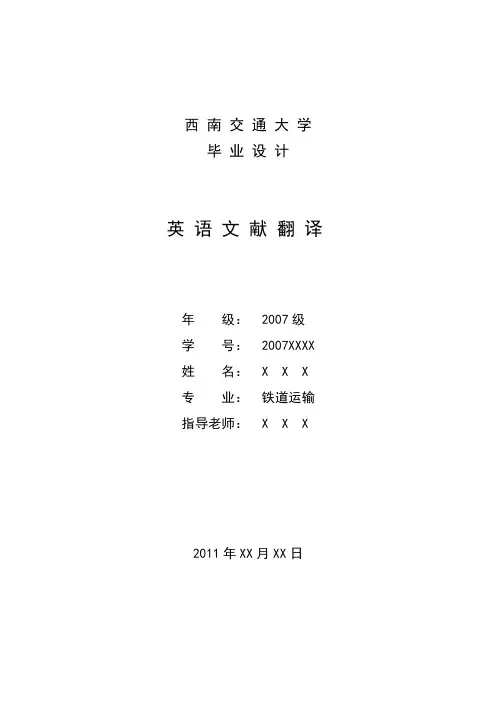
西南交通大学毕业设计英语文献翻译年级: 2007级学号: 2007XXXX姓名: X X X专业:铁道运输指导老师: X X X2011年XX月XX日Britain railway(英文)Railway safety(小四times new roman,1.5倍行距)Already rail is one of the safest forms of travel and the long term improvement in rail safety is continuing. But the Chief Inspector of Railways has warned that some operators have tried to avoid taking measures to improve rail safety standards, or worse still, to reduce them. It is vital to ensure that there is no erosion of safety standards in the privatized railway. Existing standards of health and safety must be maintained and, where necessary, improved. Operators must not put commercial considerations ahead of safety. The Health and Safety Commission, together with its operational arm the Health and Safety Executive, which includes the Railway Inspectorate, is the independent regulatory body responsible for railway safety. The Railway Inspectorate has comprehensive powers to enforce the wide-ranging duties of the Health and Safety at Work etc. Act 1974 and associated Regulations.A new safety regime for the privatized railway was put in place in 1994. It reflects Rail track’s and train operating companies' obligations under the HSWA to operate safely. Rail track has responsibilities for both setting and enforcing safety standards. The single most important element in the regime is a requirement for each operator to prepare, and obtain acceptance of, a 'safety case'- a detailed document describing the operator's risk assessments and safety management systems. The regime also gave Rail track wide-ranging responsibilities for both setting and enforcing safety standards.We are determined to ensure, as part of improving the railways in the interests of passengers, that safety is not compromised. The Health and Safety Commission fully shares this resolve. It has recently gone out to formal consultation on draft regulations to oblige the privatized industry to replace or modify Mark 1 rolling stock by 2003 and to install train protection (which would apply the brake automatically in danger situations) on all trains and at all key signals by 2004. Mark 1 rolling stock has been criticized because of how it performs in certain types of accidents. The Commission has recommended that all Mark 1 rolling stock be英国铁路(中文翻译,居中)正文,小四宋体,1.5倍行距,如有多级标题,标题写法参照毕业设计正文格式铁路可以说是最安全的出行方式之一,并且铁路安全性的长期改善是持续的。
外文参考文献译文及原文【范本模板】
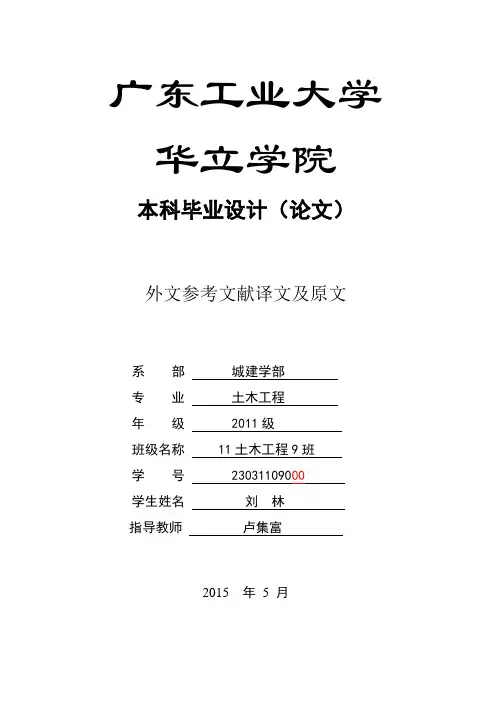
广东工业大学华立学院本科毕业设计(论文)外文参考文献译文及原文系部城建学部专业土木工程年级 2011级班级名称 11土木工程9班学号 23031109000学生姓名刘林指导教师卢集富2015 年5 月目录一、项目成本管理与控制 0二、Project Budget Monitor and Control (1)三、施工阶段承包商在控制施工成本方面所扮演的作用 (2)四、The Contractor’s Role in Building Cost Reduction After Design (4)一、外文文献译文(1)项目成本管理与控制随着市场竞争的激烈性越来越大,在每一个项目中,进行成本控制越发重要。
本文论述了在施工阶段,项目经理如何成功地控制项目预算成本。
本文讨论了很多方法。
它表明,要取得成功,项目经理必须关注这些成功的方法.1。
简介调查显示,大多数项目会碰到超出预算的问……功控制预算成本.2.项目控制和监测的概念和目的Erel and Raz (2000)指出项目控制周期包括测量成……原因以及决定纠偏措施并采取行动。
监控的目的就是纠偏措施的。
.。
标范围内。
3.建立一个有效的控制体系为了实现预算成本的目标,项目管理者需要建立一……被监测和控制是非常有帮助的。
项目成功与良好的沟通密。
决( Diallo and Thuillier, 2005).4.成本费用的检测和控制4.1对检测的优先顺序进行排序在施工阶段,很多施工活动是基于原来的计……用完了。
第四,项目管理者应该检测高风险活动,高风险活动最有。
..重要(Cotterell and Hughes, 1995)。
4.2成本控制的方法一个项目的主要费用包括员工成本、材料成本以及工期延误的成本。
为了控制这些成本费用,项目管理者首先应该建立一个成本控制系统:a)为财务数据的管理和分析工作落实责任人员b)确保按照项目的结构来合理分配所有的……它的变化-—在成本控制线上准确地记录所有恰..。
文献翻译模板(王昆)
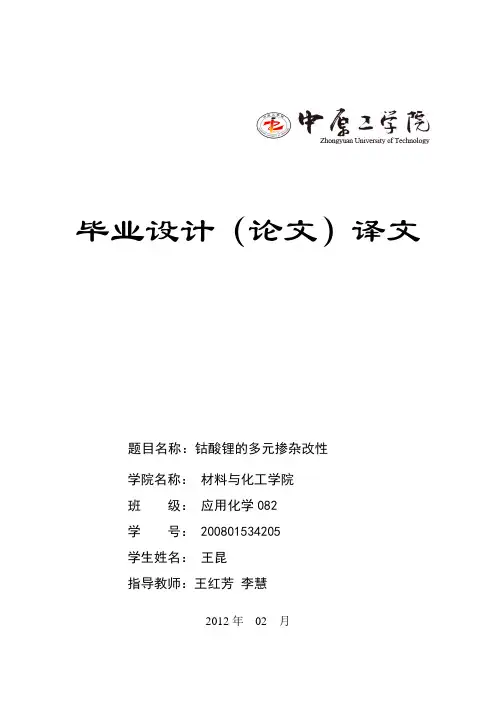
毕业设计(论文)译文题目名称:钴酸锂的多元掺杂改性学院名称:材料与化工学院班级:应用化学082学号: 200801534205学生姓名:王昆指导教师:王红芳李慧2012年02 月LiNi1/3Co1/3Mn1/3O2锂电池阴极材料高压、高容量特点的研究P.Periasamy1, N.Kalaiselvi1,*, H.S.-Kim21 Electrochemical Power Systems Division, Central Electrochemical Research Institute[CECRI],Karaikudi, India2Advanced Materials for Applied Research Laboratory, KERI, Changwon, South Korea*E-mail: kalakanth2@Received: 14 June 2007 / Accepted: 1 August 2007 / Published: 1 September 2007摘要:通过目前的研究,人们已经可以通过软化学明胶辅助基础(GAC)燃烧方法来合成LiNi1/3Co1/3Mn1/3O2阴极。
实验发现,长达24小时焙烧温度为750°C的GAC方法对制备有良好的六方排列和更好的循环性能的LiNi1/3Co1/3Mn1/3O2粉末是必要地。
峰强比I(003)/I(104)大于1,表明阳离子混排程度不大。
观测到的CV峰确定了镍、钴、锰离子都是以+3价而存在的。
当合成的LiNi1/3Co1/3Mn1/3O2阴极充电到4.6 V时,它显示出的最大放电容量可达180 mAh/g。
因此,该方法证明通过目前研究合成的LiNi1/3Co1/3Mn1/3O2阴极可以作为一个高电压和高容量的阴极材料用于充电锂电池中。
关键词:明胶辅助燃烧(GAC)方法,LiNi1/3Co1/3Mn1/3O2阴极,比容量,锂电池1 引言目前,锂离子电池除了应用于包括3C程序在内的便携式电子设备的动力来源外,它们还被认为是未来电动汽车领域最有前景的候选者。
英文文献全文翻译
英文文献全文翻译全文共四篇示例,供读者参考第一篇示例:LeGuin, Ursula K. (December 18, 2002). "Dancing at the Edge of the World: Thoughts on Words, Women, Places".《世界边缘的舞蹈:关于语言、女性和地方的思考》Introduction:In "Dancing at the Edge of the World," Ursula K. LeGuin explores the intersection of language, women, and places. She writes about the power of words, the role of women in society, and the importance of our connection to the places we inhabit. Through a series of essays, LeGuin invites readers to think critically about these topics and consider how they shape our understanding of the world.Chapter 1: LanguageConclusion:第二篇示例:IntroductionEnglish literature translation is an important field in the study of language and culture. The translation of English literature involves not only the linguistic translation of words or sentences but also the transfer of cultural meaning and emotional resonance. This article will discuss the challenges and techniques of translating English literature, as well as the importance of preserving the original author's voice and style in the translated text.Challenges in translating English literature第三篇示例:Title: The Importance of Translation of Full English TextsTranslation plays a crucial role in bringing different languages and cultures together. More specifically, translating full English texts into different languages allows for access to valuable information and insights that may otherwise be inaccessible to those who do not speak English. In this article, we will explore the importance of translating full English texts and the benefits it brings.第四篇示例:Abstract: This article discusses the importance of translating English literature and the challenges translators face when putting together a full-text translation. It highlights the skills and knowledge needed to accurately convey the meaning and tone of the original text while preserving its cultural and literary nuances. Through a detailed analysis of the translation process, this article emphasizes the crucial role translators play in bridging the gap between languages and making English literature accessible to a global audience.IntroductionEnglish literature is a rich and diverse field encompassing a wide range of genres, styles, and themes. From classic works by Shakespeare and Dickens to contemporary novels by authors like J.K. Rowling and Philip Pullman, English literature offers something for everyone. However, for non-English speakers, accessing and understanding these works can be a challenge. This is where translation comes in.Translation is the process of rendering a text from one language into another, while striving to preserve the original meaning, tone, and style of the original work. Translating afull-length English text requires a deep understanding of both languages, as well as a keen awareness of the cultural andhistorical context in which the work was written. Additionally, translators must possess strong writing skills in order to convey the beauty and complexity of the original text in a new language.Challenges of Full-text TranslationTranslating a full-length English text poses several challenges for translators. One of the most significant challenges is capturing the nuances and subtleties of the original work. English literature is known for its rich and layered language, with intricate wordplay, metaphors, and symbolism that can be difficult to convey in another language. Translators must carefully consider each word and phrase in order to accurately convey the author's intended meaning.Another challenge of full-text translation is maintaining the author's unique voice and style. Each writer has a distinct way of expressing themselves, and a good translator must be able to replicate this voice in the translated text. This requires a deep understanding of the author's writing style, as well as the ability to adapt it to the conventions of the target language.Additionally, translators must be mindful of the cultural and historical context of the original work. English literature is deeply rooted in the history and traditions of the English-speaking world, and translators must be aware of these influences in orderto accurately convey the author's intended message. This requires thorough research and a nuanced understanding of the social, political, and economic factors that shaped the work.Skills and Knowledge RequiredTo successfully translate a full-length English text, translators must possess a wide range of skills and knowledge. First and foremost, translators must be fluent in both the source language (English) and the target language. This includes a strong grasp of grammar, syntax, and vocabulary in both languages, as well as an understanding of the cultural and historical context of the works being translated.Translators must also have a keen eye for detail and a meticulous approach to their work. Every word, sentence, and paragraph must be carefully considered and translated with precision in order to accurately convey the meaning of the original text. This requires strong analytical skills and a deep understanding of the nuances and complexities of language.Furthermore, translators must possess strong writing skills in order to craft a compelling and engaging translation. Translating a full-length English text is not simply a matter of substituting one word for another; it requires creativity, imagination, and a deep appreciation for the beauty of language. Translators mustbe able to capture the rhythm, cadence, and tone of the original work in their translation, while also adapting it to the conventions of the target language.ConclusionIn conclusion, translating a full-length English text is a complex and challenging task that requires a high level of skill, knowledge, and creativity. Translators must possess a deep understanding of both the source and target languages, as well as the cultural and historical context of the work being translated. Through their careful and meticulous work, translators play a crucial role in making English literature accessible to a global audience, bridging the gap between languages and cultures. By preserving the beauty and complexity of the original text in their translations, translators enrich our understanding of literature and bring the works of English authors to readers around the world.。
外文文献译文——参考范例
本科毕业设计(论文)外文参考文献译文及原文学院自动化学院专业电气工程及其自动化(电力系统自动化方向)年级班别2011级3班学号学生姓名指导教师2015年3月10日通过对磁场的分析改进超高压变电站扩展连接器的设计Joan Hernández-Guiteras a, Jordi-Roger Ribaa,⇑, LuísRomeralba UniversitatPolitècnica de Catalunya, Electrical Engineering Department, 08222 Terrassa, Spainb UniversitatPolitècnica de Catalunya, Electronic Engineering Department, 08222 Terrassa, Spain摘要:在世界上很多的国家,电力需求的增长比输电容量的发展更快。
由于环境的限制、社会的担忧以及经济上的投入,建设新的输电线路是一项严峻的挑战。
除此以外,输电网经常要承担接近额定容量的负载。
因此,提高输电系统的效率和可靠性受到了关注。
这项研究主要针对一个400KV,3000A,50Hz的超高压变电站扩展连接器,用于连接两个母线直径均为150mm的变电站。
该变电站连接器是一个四线制的铝导线,为母线之间的相互电能传输提供了路径。
前期的初步试验显示:电流在输电线路中的不平衡分布,主要是受到了距离的影响。
应用一个三维的有限元素法,可以改进设计,以及对改进前后两个版本的连接器的电磁性能和热性能进行评估比较。
这份报告中将提出:在实验室条件下的检验已经验证了仿真方法的准确性。
这也许将会是促进变电站连接器设计进程的一个很有价值的工具。
因此,将不仅仅提高其热性能,还将提高其可靠性。
关键词:变电站连接器、超高压、电力传输系统、有限单元法、数值模拟、临近效应、热学分析1.引入全球能源需求的频繁增长,连同分散的和可再生能源份额的增长促进超高压和特高压电力传输系统[1]的建设和研究。
外文文献及翻译格式模版
毕业设计外文文献及译文文献、资料题目:INTELLIGENT BUILDING ALARM 文献、资料来源:网络文献、资料发表(出版)日期:2012,2院(部):信息与电气工程学院专业:电气工程与自动化班级:电气084姓名:邓红坤学号: 2008121017指导教师:王克河翻译日期:2012、2、29外文文献:INTELLIGENT BUILDING ALARMBACKGROUND OF THE INVENTIONThis invention relates to an intelligent alarm system for 5 detecting hazardous situations ina building informing building occupants of optimal escape routes or survival strategies and assisting emergency personnel in rescuing people inside the building。
Building hazards, including fire,earthquakes,intruders,etc., have the potential for large numbers of casualties. Effective building alarm systems must have the capability to process a plurality of input types to determine the nature of the situation involving danger to persons in thebuilding. The building alarm system must also have more than simple audio/visual outputs for helping people in the building find safe escape routes.Use of the term building in this invention refers to any structure including,but not limited to, office buildings, commercial buildings,factory/warehouses, residential homes, etc. Aspectsof building alarm systems are described 20 in, U.S。
外文文献翻译译稿和原文【范本模板】
外文文献翻译译稿1卡尔曼滤波的一个典型实例是从一组有限的,包含噪声的,通过对物体位置的观察序列(可能有偏差)预测出物体的位置的坐标及速度。
在很多工程应用(如雷达、计算机视觉)中都可以找到它的身影。
同时,卡尔曼滤波也是控制理论以及控制系统工程中的一个重要课题。
例如,对于雷达来说,人们感兴趣的是其能够跟踪目标.但目标的位置、速度、加速度的测量值往往在任何时候都有噪声。
卡尔曼滤波利用目标的动态信息,设法去掉噪声的影响,得到一个关于目标位置的好的估计.这个估计可以是对当前目标位置的估计(滤波),也可以是对于将来位置的估计(预测),也可以是对过去位置的估计(插值或平滑).命名[编辑]这种滤波方法以它的发明者鲁道夫。
E。
卡尔曼(Rudolph E. Kalman)命名,但是根据文献可知实际上Peter Swerling在更早之前就提出了一种类似的算法。
斯坦利。
施密特(Stanley Schmidt)首次实现了卡尔曼滤波器。
卡尔曼在NASA埃姆斯研究中心访问时,发现他的方法对于解决阿波罗计划的轨道预测很有用,后来阿波罗飞船的导航电脑便使用了这种滤波器。
关于这种滤波器的论文由Swerling(1958)、Kalman (1960)与Kalman and Bucy(1961)发表。
目前,卡尔曼滤波已经有很多不同的实现.卡尔曼最初提出的形式现在一般称为简单卡尔曼滤波器。
除此以外,还有施密特扩展滤波器、信息滤波器以及很多Bierman, Thornton开发的平方根滤波器的变种.也许最常见的卡尔曼滤波器是锁相环,它在收音机、计算机和几乎任何视频或通讯设备中广泛存在。
以下的讨论需要线性代数以及概率论的一般知识。
卡尔曼滤波建立在线性代数和隐马尔可夫模型(hidden Markov model)上.其基本动态系统可以用一个马尔可夫链表示,该马尔可夫链建立在一个被高斯噪声(即正态分布的噪声)干扰的线性算子上的。
系统的状态可以用一个元素为实数的向量表示.随着离散时间的每一个增加,这个线性算子就会作用在当前状态上,产生一个新的状态,并也会带入一些噪声,同时系统的一些已知的控制器的控制信息也会被加入。
- 1、下载文档前请自行甄别文档内容的完整性,平台不提供额外的编辑、内容补充、找答案等附加服务。
- 2、"仅部分预览"的文档,不可在线预览部分如存在完整性等问题,可反馈申请退款(可完整预览的文档不适用该条件!)。
- 3、如文档侵犯您的权益,请联系客服反馈,我们会尽快为您处理(人工客服工作时间:9:00-18:30)。
外文资料翻译FOREIGN LITERATURE TRANSLATION专业:财务管理姓名:指导教师姓名:财务报表欺诈的原因,后果和防治方法作者:扎比霍拉哈瑞扎伊本文摘自2005年第16 期的会计观察杂志第277页到第282页摘要: 在过去几年中,财务报表欺诈已经造成包括投资者,债权人,领年金者和员工等市场参与者,超过5000 亿美元的损失。
资本市场参与者期望警惕的和积极的企业治理能够确保信息的完整性、透明度和财务信息质量。
财务报表欺诈将会严重威胁市场参与者对公布的经审核的财务报表的信心。
最近,财务报表欺诈受到来自商界,会计界,学术界和监管机构相当高的重视。
本文将陈述(1)财务报表欺诈的定义;(2)通过对涉嫌财务报表诈骗案件的选择性样本进行评论,来呈现财务报表欺诈的轮廓;(3)论证篡改账目最终将导致财务报表欺诈和犯罪;(4)介绍预防和检测财务报表欺诈的策略来减少财务报表舞弊事件的发生。
财务报表欺诈仍然是一个受到商业组织和会计界人士的关注的重点问题,并且出现在最近的证券及交易委员会(SEC的执法行动与企业诈骗责任小组的报告中。
本文将着重讨论可能会增加财务报表欺诈行为的可能性的因素。
本文应该增加企业治理参与者(董事会董事,审计委员会,高层管理团队,内部审计人员,外部审计师,和理事机构)对财务报表欺诈和预防与检测财务报表欺诈的战略的关注程度。
2002年萨班斯法案颁布实施,其目的在于改善公司治理,财务报告质量,以及审计职能的可信性。
该法为审计上市公司的公共会计人员确立了一个新的架构,赋予上市公司及上市公司管理人员更多的责任,并增加了刑事违法行为和其他违规行为的处罚。
鉴于预防财务报表欺诈的困难程度和相关费用,应当理解在这篇文章中所描述的可以影响欺诈的发生、检测与预防财务报表欺诈的互动因素(篡改账目者,舞弊方法,激励,监督和最终结果)是与会计和审计研究相关的。
关键词:财务报表欺诈;公司治理,2002 年萨班斯法案;篡改账目;预防和检测欺诈的策略1. 简介由于大型公司(如朗讯Lucent 、施乐Xerox 、来爱德Rite Aid 、山登Cendant、上巨电子Sunbeam美国废弃物管理公司Waste Management美国安然公司Enron Corporation、环球电讯Global Crossing、世通WorldCom阿德菲亚传播公司Adelphia 和美国泰科公司Tyco)的财务报表欺诈行为被高调报道,使得财务报表欺诈引起了公众,投资者,金融界,新闻界以及监管机构的极大关注。
这些公司以及其他一些公司的高层管理人员被指控私自更改报表信息,在很多情况下,他们会被起诉并被定罪。
安然公司的破产,造成约700亿美元损失,这也使投资者,公司员工和领年金者受到了巨大的损失。
世通公司的破产被指控是由财务报表欺诈造成的。
这也是美国的历史上最大的破产案。
安然、世通、奎斯特、泰科投入、环球电讯,所造成的财务报表欺诈的损失市值约为4600 亿美元(考顿,2002)这些企业以及其它一些企业的丑闻揭示了三个重要的问题(1)美国企业的明知故犯行为是多么严重,(2)企业财务报表能否被信任,以及(3)审计人员职责缺失问题。
相信美国大多数上市公司都有负责任的企业治理体系,可靠的财务报告过程,有效的审计功能,符合道德和法律的业务经营方式,并能够不断改善提高他们收入的质量和数量。
不过,对有关篡改账目及审计失败的财务报表欺诈的广泛报道已经大大削弱了美国公众对美国企业的信心。
可靠性,透明度和财务报告程序的一致性可以让投资者作出明智的选择。
市场参与者,对投资者和债权人而言,公布的经审核的财务报表比经过粉饰的财务报表更能反映真实和公允的财务现状。
安然、世界通信公司和其他企业的丑闻,盈利重述,定制和管理盈利都将大大削弱投资者对金融体系质量和可靠性的信心。
资本市场参与者(如投资者、债权人、分析师)根据公司公布的市场财务信息作出投资决定。
因此,公布的经审核的财务报表的质量、可靠性和透明度在经济资源的有效配置中是必不可少的。
审计人员通过减少重大信息误报的风险赋予公司披露的财务报表很高的可信度。
证券与交易委员会(SEC的委员在发言中一再指出金融信息对证券市场效率的重要性。
例如,“经审计的财务报表为我们的证券市场提供了基础。
经审计的财务报表帮助投资者作出是否购买,持有或卖出特定证券的决定”。
(美国证券交易委员会,2002a)“通过允许市场发现特定证券交易的真实价格,正确的信息提高了市场的质量” (美国证券交易委员会,2002b)。
市场参与者认为较低的信息风险往往与高品质的财务报告有关。
这种低风险的信息将使资本市场更有效率,形成较低的资本成本和较高的证券价格。
由于财务报表欺诈大大降低了美国公众对美国企业的信心,所以社会、商界、会计专业人员,监管机构正致力于加强对财务报表欺诈的预防和检测。
本文将着重阐述(1)给财务报表舞弊下定义;(2)通过对涉嫌财务报表诈骗案件的选择性样本进行评论,来呈现财务报表欺诈的轮廓;(3)论证篡改账目最终将导致财务报表欺诈和犯罪;(4)介绍预防和检测财务报表欺诈的策略来减少财务报表舞弊事件的发生。
2. 财务报表欺诈财务报表舞弊是企业通过编写和传播虚假的财务报表来蓄意欺骗或误导财务报表的使用者,尤其是投资者和债权人。
财务报表欺诈是由知识渊博者(如高管团队,审计人员)设计的一个相当大的并且经过周密策划的故意欺骗行为。
财务报表欺诈可能涉及下列计划(1)伪造,篡改,或操纵财务记录材料,证明文件,或商业交易;(2)重大的故意虚报,遗漏或错报事件、交易、帐目或其他重要的财务报表的编制资料;(3)蓄意不当使用,故意曲解会计准则、原则、政策和用于测量、识别、报告经济活动和商业交易的方法;(4)故意冗长地披露或不充分地披露相关的会计标准、原则、惯例及相关的财务信息;(5)通过利用积极的会计方法进行非法盈余管理;(6)根据会计实务操控会计方法,由于现有的会计方法过于详细、易于标准化并且存在很多漏洞,这些使得公司可以隐藏他们的经济实质。
3. 财务报表舞弊的概述在过去的几年中,财务报表欺诈已造成投资者超过5000 亿美元的损失(考顿,2002)。
安然公司财务报表欺诈犯造成投资者、公司员工和在退休账目中持有公司股票的领年金者估计约700 亿美元的股票市值损失。
美国总会计办公室(GAO)2002 年10 月公布了一份报告,报告表明在过去数年间因会计违规而发生的会计重述行为的数量显著增长。
美国总会计办公室研究报告表明自1997 年1 月至2002 年6 月30 日至少约10%的上市公司宣布会计报表重述,这段时间增长了145%,这一数据预计到2002 年年底将增长到170%(美国总会计办公室,2002年)。
表1总结了最近发生的财务报表欺诈案件样本,包括安然、世通、环球。
通过对这些案例深入研究,说明这些引人注目的财务报表舞弊指控的情况的发生都可以用五个互动因素来解释和论证。
这些因素被称为篡改报表、解决方法、激励、监督和最终结果,可以以CRIME简称(瑞扎伊,2002)。
这些因素的最佳组合是下面要讨论的财务报表欺诈犯罪的先决条件。
这种“五个互动因素”模式(简称CRIME加深了人们对于财务报表欺诈行为的认识。
首先,它增加了财务报表欺诈的认识,这些认识主要集中在五个互动因素上,它们同时解释影响财务报表欺诈行为的原因。
第二,它强调了警觉的有效的公司治理的参与者的重要性,它包括董事会、审计委员会、管理层、内部审计人员、外部审计师和监管机构(如证券交易委员会、美国证券交易委员会、美国注册会计师、美国注册会计师协会),可以起到预防和检测财务报表欺诈的作用。
最后,由国会提出欺诈预防和检查的战略(如萨班斯法案,2002年),由监管机构(如证券交易委员会的认证要求,加快申报截止日期)与会计专业人员(如美国注册会计师协会的六个领导角色)加强改善公司治理、财务报告的质量、审计报告的信誉和减少财务报告欺诈事件。
3.1 篡改账目者“CRIME 一词中的第一个字母是“ C',这代表的是“篡改账目者”。
国际总会计办公室的报告(2002年)显示,2001年1月至2002年2月,150家会计有关的证交会中几乎占75%的案件由上市公司或其董事、高级职员所带来,而其他的25%涉及到会计师事务所和注册会计师的参与。
在表1 中介绍的财务报表欺诈事件和1999年COS(报告(比斯利,1999年)显示,在大多数情况下(超过80%),行政总裁、财务总监(首席财务官)涉嫌财务报表欺诈。
其他与财务报表欺诈有关的个人包括:行政操作人员、董事会成员、其他高级副总裁,以及内部与外部审计师。
财务报表欺诈的发生多数涉及到企业高层管理团队包括首席执行官、首席财务官、总裁、会计主管、出纳的参与、鼓励、批准和相关知识的提供。
达成共识可能是上市公司管理团队出现新的财务报表欺诈行为或不作为,故意或无意的结果。
这已被用来作为控股公司的官员亲自负责的财务报表欺诈、承担损失、并接受罚款以及潜在的监禁的基础和理由。
在子公司和区域分公表一财务报表舞弊案件样本公司篡改账目者舞弊方法激励监督结果极光食品首席执行官、首高估报告收益,通过夸大公司董事会和审计偿还高管人员或席财务官、高级低估贸易营销财务业绩来募委员会缺乏警董事会成员的奖金融分析师、客费用集上市资金同惕性;管理层疏金,股票价格大户金融服务经时满足分析师于管理幅度降低理的预测胜腾公司三位前高级管自1995 年至高价卖出传媒缺少健全的公造成超过15 亿理人员1997 年通过高大学和胜腾的司治理制度,审美元的市值和与估500 万的收入股票计职能失灵会计师事务所的来进行盈余管理。
诉讼损失安然公司董事会主席、首成立由专门用误导投资者对缺少健全的公申请了破产保席运营官、首席途的实体 (经济公司盈利能力司治理制度,审护,造成了超过财务官伙伴)来(1)和债务情况计职能失灵60 亿美元的市隐藏债务; (2)创值损失,被提起造普通的所有了20 多个集体者权益; (3) 高估盈利诉讼环球电讯高层管理人员,误导和披露虚高估公司收入缺少勤奋的管申请破产保护,公司的主要职假的财务报表,来满足公司的理人员,审计职造成超过40 亿员进行内幕交易造成股票市值虚增绩效目标能失灵美元的市值损失家庭票房频道四个高级管理自1997 年至超过分析师的缺少警觉的董股价在一天间下公司人员,运营总裁1999 年 3 月进季度盈余预测事会和审计委跌大于50%,并行盈余管理员会,缺少勤奋引发了一系列的的管理人员集体诉讼案件智件管理团队通过虚假的软件销售来虚增财务报告中的盈利满足分析师的盈利预测缺少勤奋的管理人员;公司治理制度不健全公司以约定好的股价的一半被收购微策略三个高层管理高估公司的收炒高股票价格缺少勤奋的管重述以前年度的人员入来增大对发行理人员;缺少警财务报告引起了的新股的需求觉的董事会和股价约92.4% 的审计委员会下跌新光公司首席执行官和4运用虚构收入改善公司绩效,不健全的公司对涉案的相关人个前公司高管和非法交易的重组战略来满治理制度;审计员处以民事和渐方法进行盈余足分析师的预职能失灵进处罚并取消他管理测们在任一其他公司担任管理层的资格世通首席财务官,财通过非法和故抬高股票价格,贪婪和傲慢的申请破产保护和务主管和其他意的手段来记掩盖财政困难管理人员,不负被提关于刑事诈只要管理人员录和高估超过责任的其热治骗的起法律诉讼70亿美元的收理和无效的审入计职能司的欺诈实例通常涉及企业高级官员。
